Charles François Dumouriez | |
|---|---|
 Portrait miniature by de:Pierre-Louis Bouvier, 1796/7 | |
| Born | 26 January 1739 Cambrai, Kingdom of France |
| Died | 14 March 1823 (aged 84) Turville, United Kingdom |
| Buried | |
| Allegiance | |
| Service/ | |
| Years of service | 1758–1814 |
| Rank | Divisional general |
| Battles/wars | |
| Awards | Order of Saint Louis Names inscribed under the Arc de Triomphe |
| Other work | Minister of War, Minister of Foreign Affairs (France) |
| Signature | |
Charles-François du Périer Dumouriez (French pronunciation: [ʃaʁl fʁɑ̃swa dy peʁje dymuʁje], 26 January 1739 – 14 March 1823) was a French military officer, minister of Foreign Affairs, minister of War in a Girondin cabinet and army general during the French Revolutionary War. Dumouriez is one of the names inscribed under the Arc de Triomphe, on Column 3.
With General Kellermann he shared the first French victory at Valmy where the Prussian army was forced to draw back. He rapidly advanced north (till Moerdijk); before entering Holland he decided to return to Brussels when the French armies lost territory in the east of Belgium and the Siege of Maastricht (1793). He disagreed with his successor Pache, the radical Convention and Jacobin deputies, like Robespierre and Marat, on the annexation of the wealthy Netherlands and the introduction of assignats. After losing the Battle of Neerwinden (1793), he deserted the Revolutionary Army. He refused to surrender himself to the recently installed Revolutionary Tribunal - as he would be executed - and defected to the Austrian army.[1][2]
Early life
Dumouriez was born in Cambrai, on the Scheldt River in northern France, to parents of noble rank. His father, Antoine-François du Périer, served as a commissary of the royal army, and educated his son most carefully and widely. He continued his studies in Paris at the Lycée Louis-le-Grand, and was then sent to his uncle in Versailles for a year. In 1757 began his military career as a volunteer and served in six campaigns of the Seven Years' War. In the Battle of Rossbach, he served as a cornet in the Régiment d'Escars. He was stationed in Emden, Münster, Wesel and carried a small library with him.[3] He received a commission for good conduct in action, with distinction (receiving 22 wounds during the battle of Corbach). In 1761 he recovered in the baths at Aachen. After the peace of Hubertusburg he retired at Abbeville as a captain, with a small pension (which was never paid), a love affair with his niece and the cross of St Louis.[4]
Dumouriez then visited Italy, Spain and Corsica, and his memoranda to the duc de Choiseul on Corsican afairs at the time of the Corsican Republic led to his re-employment on the staff of the French expeditionary corps sent to the island, for which he gained the rank of lieutenant-colonel.[4] In 1769 Choiseul gave Dumouriez a military command as deputy quartermaster general to the army under the Marquis de Chauvelin.[3] After two campaigns on the island, he became a member of the Secret du Roi, the secret service under Louis XV, which gave full scope to his diplomatic skills. The fall of Choiseul (1770) brought about Dumouriez's recall. In 1770 he undertook a mission into Poland, where, in addition to his political business, he organized a Polish militia for the Bar Confederation.[4] There he met with Jozef Miaczinsky, the commander of a regiment. His Polish soldiers were pushed back by the Russian forces of General Alexander Suvorov in the first clash but Suvorov failed in the second clash. On 21 May 1771, Dumouriez' Polish soldiers were smashed in the third clash.
In 1772, upon returning to Paris, Dumouriez sought a military position from the marquis de Monteynard, Secretary of State for War, who gave him a staff position with the regiment of Lorraine writing diplomatic and military reports. In 1773, he was arrested in Hamburg found himself imprisoned in the Bastille for six months, apparently for diverting funds intended for the employment of secret agents into the payment of personal debts. During his captivity Dumouriez occupied himself with literary pursuits. He was sent to Caen, where he remained in detention until the accession of Louis XVI in 1774. Dumouriez was then recalled to Paris and assigned to posts in Lille and Boulogne-sur-Mer by the comte de Saint-Germain, the new king's minister of war.

Upon his release, Dumouriez married his cousin, a certain Mademoiselle de Broissy. In the meantime, Dumouriez had turned his attention to the internal state of his own country, and amongst the very numerous memoranda which he sent to the government was a project on the defence of Normandy and Cherbourg navy port, which procured for him in 1778 the post of commandant of Cherbourg.[5] He administered it with much success for more than ten years.[6] The construction of the fortifications and dikes began in 1779/1782 and extended in 1786. He used a plan by Vauban to create an outer port.[3] The city grew and even the King came to La Manche see it. For his ingenuity in fortifying he became a maréchal de camp in 1788. After the Storming of the Bastille he became commander of the National Guard in July 1789, but his ambition was not satisfied.[4] Business and trade dropped in Cherbourg.[7] He proved a neglectful and unfaithful husband, and the couple separated. Madame Dumouriez took refuge in a convent.
Political career
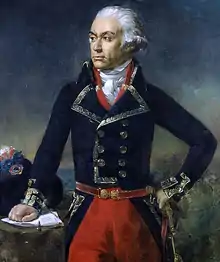
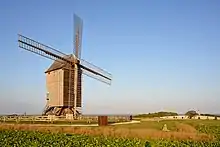

At the outbreak of the Revolution, seeing the opportunity for carving out a new career, he went to Paris, where he joined the Jacobin Club. In 1790, Dumouriez was appointed French military advisor to the newly established United Belgium States and remained dedicated to the cause of an independent Belgian Republic.[8] In 1791 he was sent to the coast. The death of Mirabeau, to whose fortunes he had attached himself, proved a great blow. However, opportunity arose again when, in his capacity as a lieutenant-general and the commandant of Nantes, he offered to march to the assistance of the National Constituent Assembly after the royal family's unsuccessful flight to Varennes.[4] Minister of War, Louis Lebègue Duportail, promoted Dumouriez from president of the War Council to major-general in June 1791 and attached him to the Twelfth Division, which was commanded by General Jacques Alexis de Verteuil.
He then attached himself to the Girondist party and, on 15 March 1792, became the French minister of foreign affairs. In March 1792 selected Lebrun-Tondu as his first officer for Belgian and Liégeois affairs.[8] The relationship between the Girondists and Dumouriez was not based on ideology, but rather based on the practical benefit it gave to both parties. Dumouriez needed people in the Legislative Assembly to support him, and the Girondists needed a general to give them legitimacy in the army.[9] He played a major part in the declaration of war against Austria (20 April), and he ordered General Dillon, commander of Lille, to attack Tournai, and the invasion of the Austrian Netherlands. His foreign policy was greatly influenced by Jean-Louis Favier.[10] Favier had called for France to break its ties with Austria.
On the king's dismissal of Roland, Clavière and Servan (13 June 1792), he took Servan's post of minister of war, but resigned it a few days days later on account of Louis XVI's refusal to come to terms with the National Constituent Assembly, concerning his suspensive veto. Within a week he joined the army of the North under Marshal Luckner. After the émeute of 10 August 1792 and Lafayette’s flight, he gained appointment to the command of the "Army of the Centre". At the same moment, France's enemies assumed the offensive. Dumouriez acted promptly from Sedan, Ardennes.
On August 24, 1792, Dumouriez wrote to his ally General François Kellermann about the void in military power within France. Within this letter, Dumouriez voices his opinions adamantly that Lafayette was a "traitor"[11] to France after being arrested for mobilizing his army from the borders of France to Paris to protect the Royal family from revolutionaries who were dissatisfied with the monarchy of France at the time. Within this letter, Dumouriez's attachment to the Jacobin club is explicitly present as he tells Kellermann that the army was finally "purged of aristocrats".[12] Dumouriez's loyalty to France's military which was evident within this letter was instrumental to him ascending to his future position of Foreign Minister of France from March 1792 to June 1792, restoring the natural borders of France. Dumouriez outmaneuvered the invading forces of the Duke of Brunswick in the forest of Argonne. His subordinate Kellermann repulsed the Prussians at Valmy (20 September 1792). After these military victories, Dumouriez was ready to invade Belgium to spread revolution in the Flanders campaign.
Army of the North

Supported by minister Lebrun-Tondu, he declared in the National Convention on 12 October that he would liberate the Belgians and the Liège people. On 27 October 1792, he invaded the Austrian Netherlands. Dumouriez himself severely defeated the Austrians at Jemappes (6 November 1792).[4] He became a military hero for this decisive victory, for which the newspaper "Révolutions de Paris" proclaimed him the liberator of the Belgians.[13] On 14 November he arrived in Brussels. Several times he received a mission of Dutch revolutionary patriots, with whom he agreed on the principles; De Kock, Daendels and his friends settled in Antwerp.[14] Cambon pointed at the empty treasury and the wealthy Dutch. Dumouriez wrote a letter to the Convention scolding it for not supplying his army to his satisfaction and for the Decree of 15 December, which allowed the French armies to loot in the territory they had won, besides the introduction of the inflation-prone assignats in the conquered areas, and to expropriate church property.[15][16] The Decree insured that any plan concerning Belgium would fail due to a lack of popular support among the Belgians.
Dumouriez wanted to establish an independent Belgian state, free of Austrian control, which would act as a buffer on France's eastern borders, but that would not worry the British. To achieve this he began negotiations with the local authorities in Belgium, but on 15 December the Convention passed a decree ordering the military commanders in the occupied territories to implement all revolutionary laws.[17]
War with the Dutch Republic

Returning to Paris on 1 January 1793, Dumouriez encountered popular ovation, but he gained less sympathy from the revolutionary government. On 12 January he had a meeting with Lebrun-Tondu; on 23 January he was sent back.[18] The Dutch were willing to pay and an invasion of the Netherlands was postponed. To the more radical elements in Paris, it became clear that Dumouriez was not a true patriot but worked during the trial of Louis XVI to save him from execution. On 29 January Dumouriez lost his negotiating mandate.[19] With the help of the Girondists, Dumouriez ensured that defaulting Pache had to resign at the end of January 1793;[20] at the most critical moment of the war.[21]
.jpg.webp)
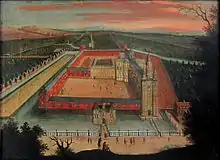
To declare war had always been a prerogative of the king. On 1 February Brissot declared war against King of Great Britain and the stadtholder of the Dutch Republic, not the people. The next day Francisco de Miranda, the only general from Latin America in French service, gave the command of the French forces back to Dumouriez. Although Dumouriez advised the government simply to recognise Belgium's independence, the Jacobins sent several agents.[22] On 7 February Dumouriez appreciated the secret proposals of Van de Spiegel and Baron Auckland: in exchange for recognition of French Republic, France would have to refrain from aggression against other countries.[23] On 15 February, Johan Valckenaer addressed Cambon, the president of the Convention, to give not the committee but Dumouriez all powers to depose regents and restore others to power.[24] Lazare Carnot proposed that annexation be undertaken on behalf of French interests whether or not the people to be annexed so wished.[25] On 17 February 1793, the French troops and the Batavian Legion crossed the Dutch border. Miranda, Stengel, Dampierre, Valence, and Eustace went northeast; Dumouriez and Daendels went northwest. Breda, Klundert, and Geertruidenberg were occupied with an army of Sans-Culottes that lacked almost everything.[26] After the French lost Venlo, Aachen, Maastricht and all the supply at Liège in early March,[27] Dumouriez was ordered to return to Brussels rather than further entering Holland.[28][29] The situation was alarming. Miranda wrote Dumouriez to continue his plan and not return to Belgium.[30]
On 11 March, Dumouriez addressed the Brussels assembly, apologizing for the actions of the French commissioners and looting soldiers.[31] On 12 March Dumouriez wrote an angry, insolent letter which is considered a "declaration of war on the Convention".[32][9] He criticized the interference of officials of the War Ministry which employed many Jacobins.[33] He attacked not only Pache, the former minister of war, but also Marat and Robespierre.[34] Meanwhile Danton initiated the creation of the Revolutionary Tribunal to interrogate the generals at some time. Dumouriez had long been unable to agree with the course of the Convention. He was disenchanted with the radicalization of the revolution and its politics and put an end to the annexation efforts.[35] He was liked by the Belgium population. It seems both Eustace and Miranda disagreed; on 14 March Eustace wrote a letter to Dumouriez.[36] On 18 March 1793, Dumouriez's army attacked the Governor of the Habsburg Netherlands, also the brother of the Austrian emperor, Josias of Saxe-Coburg-Saalfeld's army. A major defeat in the Battle of Neerwinden nearly ended the French invasion. On 20 March Danton and Charles-François Delacroix were sent to Louvain.[37] On 22 March Dumouriez opened negotiations with the Austrian General Mack.[38] He allowed Dumouriez to retreat to Brussels; Dumouriez' soldiers were deserting in large numbers. The next day Dumouriez promised the Austrians he would leave Belgium (though he had no permission and was without approval of the convention.[39])
Dumouriez had long been unable to agree with the course of the Convention. Dumouriez prevented the execution of the decrees of 15 and 27 December, according Robespierre.[40] He did not want the Dutch Republic to come under French authority, or even to be incorporated. It was his army that liberated the south of the Netherlands, and he would not allow it to fall into the hands of commissioners of the Convention. On 25 March Dumouriez asked Karl Mack for his support to march on Paris.[41] There he would negotiate peace, dissolve the convention, restore the French Constitution of 1791, plea for the restoration of a constitutional monarchy, and free Marie-Antoinette and her children.[42][43] He urged Louis Philippe I Duke of Chartres, though still a teenager, to join his plan. The Jacobin leaders were quite sure that France had come close to a military coup mounted by Dumouriez and supported by Pétion and Brissot de Warville.
Dumouriez' defection
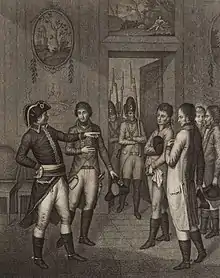

_(14757841216).jpg.webp)
On 25 March Robespierre became one of members of the Committee of General Defence, to coordinate the war effort.[44] By the end of the month Robespierre called for the removal of Dumouriez, who in his eyes aspired to become a Belgian dictator.[45][46][47] A body of four commissioners was sent to question and arrest him.[48][49] The commissioners Camus, Bancal-des-Issarts, Quinette, and Lamarque were accompanied by the acting Minister of War, Pierre Riel de Beurnonville. Dumouriez sensed a trap and invited them to his headquarters at Saint-Amand-les-Eaux and ordered Miaczinski to arrest them at Orchies.[lower-alpha 1] After an hour of deliberations he refused to accept the decree by the convention to go with them to Lille and Paris.[59] Instead Dumouriez arrested the five and sent them over to General Clerfayt on the next day.[lower-alpha 2]
Robespierre was convinced Brissot and Dumouriez wanted to overthrow the First French Republic.[61] On 3 April Robespierre declared before the Convention that the whole war was a prepared game between Dumouriez and Brissot to overthrow the First French Republic.[62]
On 4 April the convention declared Dumouriez a traitor and outlaw and put a price on his head.[63] Davout's volunteer battalion tried to arrest Dumouriez.[60][64] Dumouriez unsuccessfully tried to persuade Davout to his side and made a move to save himself from his radical enemies. He attempted to persuade his troops to march on Paris and overthrow the revolutionary government. The attempt proved unfeasible because many of his soldiers were staunch republicans and several of his officers opposed him.[4] Without escort he rode on horseback to Tournai,[65] along with his chief of staff Pierre Thouvenot, the Duke of Chartres, duc de Montpensier he arrived on 5 April 1793 into the Austrian camp at Maulde. This blow left the Brissotins vulnerable due to their association with Dumouriez. Dumouriez's defection changed the course of the events for the Brissotins. On 6 April the Committee of Public Safety was installed. Suspicion rose against Phillipe Égalité, because of his eldest son who fled with Dumouriez in the Austrian camp. Philippe Égalité was then put under continuous surveillance.
In Brussels Dumouriez met with Metternich and received a passport for Germany. On 10 April Robespierre accused him in a speech: "Dumouriez and his supporters have brought a fatal blow to the public fortune, preventing circulation of assignats in Belgium".[47]
The French armies took positions behind the frontier. The Army of Holland deployed near Lille, the Army of the Ardennes at Maulde, the Army of the North at Saint-Amand, and the Army of Belgium at Condé-sur-l'Escaut and Valenciennes.[66]
Later life and death
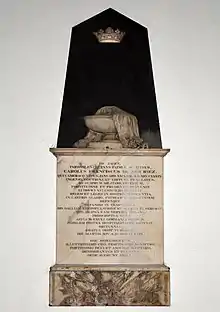
Following his defection on 5 April 1793, Dumouriez remained in Brussels for a short time, and then travelled to Cologne, seeking a position at the elector's court. He soon learned he had become an object of suspicion among his countrymen, the royal houses, aristocracies, and clergy of Europe. In response, Dumouriez wrote and published in Hamburg (1794) a first volume of memoirs in which he offered his version of the previous year's events. He became a royalist intriguer during the reign of Napoleon as well as an adviser to the British government. Dumouriez wrote political pamphlets and letters analyzing the coastal defence of England and Ireland.[67][68]
Dumouriez now wandered from country to country, occupied in ceaseless royalist intrigues, until 1804 when he settled in England, where the British government granted him a pension. He became a valuable adviser to the British War Office, and the Duke of York and Albany in his struggle against Napoleon's planned invasion of the United Kingdom, and the British anti-invasion preparations of 1803–05.[69]
In 1808 Castlereagh had been warned by Dumouriez that the best policy England could adopt with respect to colonies in Spanish America was to relinquish all ideas of military conquest by Arthur Wellesley and instead support the emancipation of the territories. Furthermore, Dumouriez suggested that once emancipation was achieved, a constitutional monarchy should be established with the exiled Duke of Orleans as King.[70]
In 1814 and 1815, he endeavoured to procure from Louis XVIII the baton of a marshal of France, but failed to do so.[4] He died at Turville Park, near Henley-on-Thames, on 14 March 1823.[4] An enlarged edition, La Vie et les mémoires du Général Dumouriez, appeared at Paris in 1823.
References

- ↑ P.C. Howe (1982) Foreign Policy and the French Revolution, p. 179-180
- ↑ Banat 2006, p. 396.
- 1 2 3 "La vie et les mémoires du général Dumouriez". 1822.
- 1 2 3 4 5 6 7 8 9 One or more of the preceding sentences incorporates text from a publication now in the public domain: Chisholm, Hugh, ed. (1911). "Dumouriez, Charles François". Encyclopædia Britannica. Vol. 8 (11th ed.). Cambridge University Press. p. 667.
- ↑ "Charles François du Perrier Dumouriez (1739-1823)".
- ↑ "Charles-François du Périer Dumouriez | French general | Britannica".
- ↑ Mémoires 2, p. 247
- 1 2 P.C. Howe, p. 2
- 1 2 Brace, Richard Munthe, General Dumouriez and the Girondins 1792-1793, in The American Historical Review, Vol. 56, No. 3, (April, 1951), pp. 493-509.
- ↑ Savage, Gary. Favier’s Heirs: The French Revolution and the Secret du Roi, in The Historical Journal, Vol. 41, No. 1, (March 1998), pp. 225-258.
- ↑ "From Hero To 'Traitor': The French Revolution." Lafayette: Citizen of Two Worlds. Cornell University, n.d. Web. 26 Mar. 2017. <http://rmc.library.cornell.edu/lafayette/exhibition/english/traitor/>
- ↑ Dumouriez, Charles François. "Letter to General François Kellermann". 24 August 1792.<http://rmc.library.cornell.edu/lafayette/exhibition/pdf/REX029_051.pdf>
- ↑ "Department of History." Illustrations from Révolutions De Paris | Department of History. N.p., n.d. Web. 19 Feb. 2017.
- ↑ J. Rosendaal, p. 349, 351, 355, 361
- ↑ Hubrecht G. Les assignats en Belgique. In: Revue belge de philologie et d'histoire, tome 29, fasc. 2-3, 1951. pp. 455-459. DOI : https://doi.org/10.3406/rbph.1951.2098 www.persee.fr/doc/rbph_0035-0818_1951_num_29_2_2098
- ↑ P.C. Howe, p. 117-119, 123,
- ↑ Rickard, J. (2009), Charles François Dumouriez, 1739-1823
- ↑ J. Rosendaal, p. 369
- ↑ J. Rosendaal, p. 370-371
- ↑ Richard Munthe Brace: General Dumouriez and the Girondins 1792–1793. In American Historical Review 56, Nr. 3, (1951), S. 499 f.
- ↑ Banat 2006, p. 379.
- ↑ Mémoires du général Dumouriez, Band 2, p. 67, 78, 123
- ↑ J. Rosendaal, p. 371
- ↑ J. Rosendaal, pp. 389, 693; note 168
- ↑ P.C. Howe (2018) Foreign Policy and the French Revolution, p. 154
- ↑ Mémoires du général Dumouriez, Band 2, p. 27, 30, 32, 38, 42, 54
- ↑ "Chapter 16. Robespierre’s Putsch ( June 1793)". Revolutionary Ideas: An Intellectual History of the French Revolution from The Rights of Man to Robespierre, Princeton: Princeton University Press, 2014, pp. 420-449.
- ↑ Mémoires du général Dumouriez, Band 2, p. 61
- ↑ Patricia Chastain Howe (2008) Foreign policy and the French Revolution. Charles-Francois Doyle, Pierre Lebrun, and the Belgian Plan, 1789-1793. Palgrave Macmillan, London, p. 159, 172
- ↑ Dumouriez par Arthur Chuquet, p. 164
- ↑ P.C. Howe, p. 160
- ↑ Wikisource: Œuvres complètes de Maximilien Robespierre. Speech Robespierre against Brissot and the girondins Delivered to the Convention on 10 April 1793
- ↑ I. Davidson, p. 108, 150
- ↑ Sampson Perry (1796) An Historical Sketch of the French Revolution. Band 2, p. 377
- ↑ P.C. Howe, p. 162
- ↑ "Founders Online: To Alexander Hamilton from John Skey Eustace, [20 November 1798]".
- ↑ Mémoires 4, p. 139
- ↑ Mémoires du général Dumouriez, Band 2, p. 127
- ↑ P.C. Howe, p. 164, 166
- ↑ Wikisource: Œuvres complètes de Maximilien Robespierre. Speech Robespierre against Brissot and the girondins Delivered to the Convention on 10 April 1793
- ↑ Dumouriez par Arthur Chuquet, p. 185
- ↑ Dinwiddy, J. R. (1 July 1992). Radicalism and Reform in Britain, 1780–1850. A&C Black. ISBN 978-0-8264-3453-1 – via Google Books.
- ↑ P.C. Howe (1982) Foreign Policy and the French Revolution, p. 175-176
- ↑ France and Its Revolutions: G. Long (1850) A Pictorial History 1789–1848, p. 265
- ↑ P.C. Howe, p. 167
- ↑ Dumouriez par Arthur Chuquet, p. 181
- 1 2 Wikisource: Œuvres complètes de Maximilien Robespierre. Speech Robespierre against Brissot and the girondins Delivered to the Convention on 10 April 1793 Discours contre Brissot & les girondins
- ↑ La vie et les mémoires du général Dumouriez, p. 129
- ↑ Thompson, J.M. (1929) Leaders of the French Revolution, p. 215
- 1 2 3 Banat 2006, p. 392.
- ↑ Bulletin des Amis de la Vérité, 7 avril 1793, p. 2
- ↑ Bulletin Du Tribunal Criminel Révolutionnaire, p. 148, 151
- ↑ Leleu E. La tentative de Dumouriez sur Lille en 1793. In: Revue du Nord, tome 9, n°34, mai 1923. pp. 81-109. DOI : https://doi.org/10.3406/rnord.1923.1342 www.persee.fr/doc/rnord_0035-2624_1923_num_9_34_1342
- ↑ Le Républicain français, 5 avril 1793; Mercure français, 13 avril 1793
- ↑ H. Wallon (1880-1882) Histoire du tribunal révolutionnaire de Paris: avec le journal de ses actes, p. 101-103
- ↑ Nouvelles politiques, nationales et étrangères, 6 avril 179
- ↑ p. 139, 157-158
- ↑ Banat 2006, p. 461.
- ↑ La vie et les mémoires du général Dumouriez, p. 149, 157-159, 164-165, 175-176, 187-188, 207
- 1 2 Un Général diplomate au temps de la révolution
- ↑ Journal des débats et des décrets, 3 avril 1793
- ↑ "Speech against Dumouriez and Brissot, to be delivered at the Jacobin Club on April 3, 1793". Archived from the original on January 28, 2023. Retrieved January 22, 2023.
- ↑ Banat 2006, p. 398.
- ↑ Daniel Reichel (1975) Davout et l'art de la guerre: recherches sur la formation, l'action pendant la Revolution et les commandements du maréchal Davout, duc d'Auerstaedt, prince d'Eckmühl, 1770-1823
- ↑ Mémoires du général Dumouriez, Band 2, p. 207
- ↑ Phipps, Ramsay Weston (2011). The Armies of the First French Republic: Volume I The Armée du Nord. USA: Pickle Partners Publishing. pp. 155–157. ISBN 978-1-908692-24-5.
- ↑ 'Mémoire militaire sur l'Angleterre (1799)
- ↑ John Holland Rose and Alexander Meyrick Broadley (1909) Dumouriez and the Defence of England Against Napoleon
- ↑ French plans for the invasion of England, ca. 1804
- ↑ Great Britain and Argentina by K. Gallo, p. 87
Note
- ↑ The commissioners were escorted by Chevalier de Saint-Georges,[50] who immediately drove back to Lille.[51][50][52][53][50] In the evening Lille was successfully defended by Saint-Georges against Miaczinsky who was sent by Dumouriez to seize the city[54][55] His troops were forced to camp outside the city walls.[56] It is supposed that Dumouriez sent Miaczinsky to Lille and arrest the other seven commissioners. Saint-Georges who kept the troops outside the walls became the hero.[57] Dumouriez blamed the famous mulatto for thwarting his plans.[58] Saint-Georges prohibited the arrest of the other commissioner. Instead Miaczinsky was arrested and taken to Paris by the commissioners. After a trial on 17 May he was executed.
- ↑ In the evening he had supper with Madame de Genlis.[60]
Sources
- Patricia Chastain Howe (2008) Foreign Policy and the French Revolution. Charles- François Dumouriez, Pierre LeBrun, and the Belgian Plan, 1789–1793
- J.M. Thompson (1929) Leaders of the French Revolution: Dumouriez, p. 200-216
- Banat, Gabriel (2006). The Chevalier de Saint-Georges: Virtuoso of the Sword and the Bow. Hillsdale, New York: Pendragon Press. ISBN 978-1-57647-109-8. OCLC 63703876.